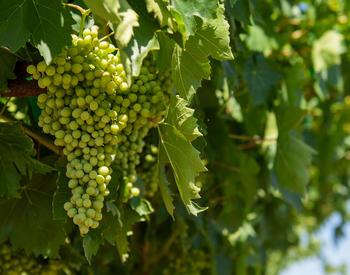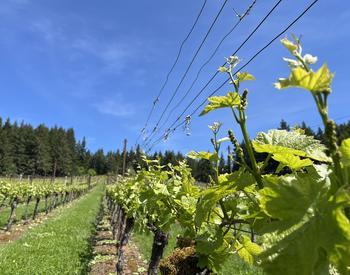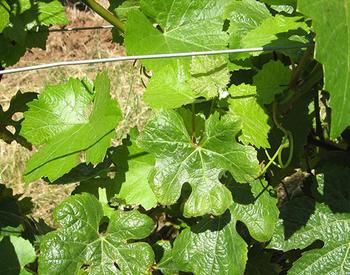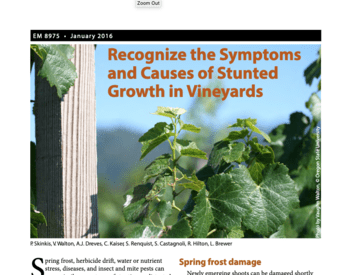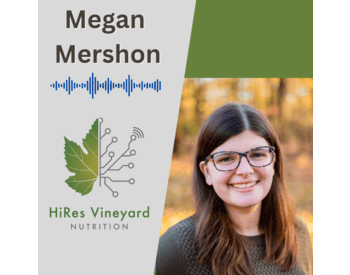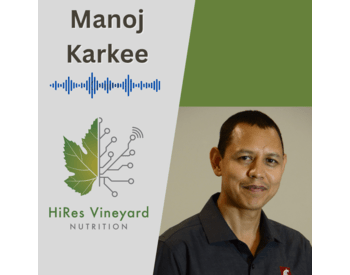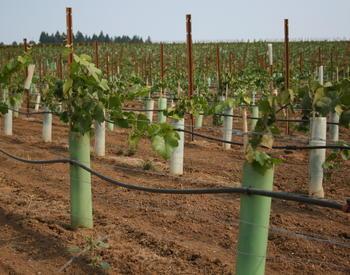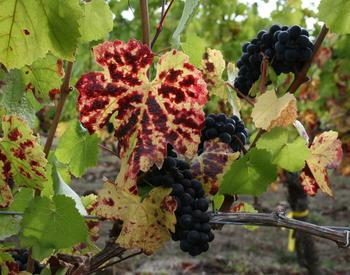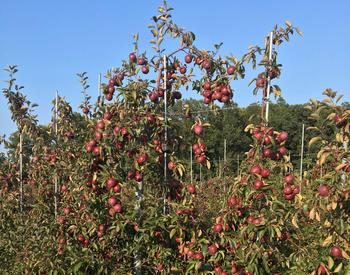Transcript
(00:00:00) Patty Skinkis
This is the High-Res Vineyard Nutrition Podcast, devoted to helping the grape and wine industry understand more about how to monitor and manage vineyard health through grapevine nutrition research. I am your host, Dr. Patty Skinkis, Professor and Viticulture Extension Specialist at Oregon State University.
(00:00:24) Patty Skinkis
As an extension specialist I get many questions from growers about how to interpret their soil tests to determine their fertilization plans in their vineyards and looking into the grapevine for nutrient testing is ideal, so, looking specifically at the tissues. Yet, there are some growers that would rather just test their soils, or some who use varied methods of tissue testing. We have been recommending to growers that they use bloom time petiole samples for quite some time and this is the most common tissue type and time point for analysis and interpretation of grapevine nutrition status across the US. However, more recent work shows that leaf blades and the veraison time point may be better for some nutrients, and there is more to learn, clearly, about how to best sample, how to get the analysis done and the interpretation of that analysis. So, here with us today to discuss nutrient monitoring methods and interpretations for vine physiology is Dr. Paul Schreiner. Paul is a research plant physiologist at the USDA Agriculture Research Service right here at the Corvallis, Oregon-based Horticultural Crops Research Laboratory. I’ve had the pleasure of working with him for the last fifteen years that I’ve been here in Oregon, and he does really great research. He conducts research on root and nutrient physiology of grape vines with a focus on the role of arbuscular mycorrhizal fungi, or AMF, in nutrient management. Paul received a Bachelor’s of Science in biochemistry and has a PhD in plant physiology, both from Penn State University. Paul has worked on mycorrhizal fungi for more than 30 years and on grapevine physiology for more than 20 years. He has many peer-refereed publications on his record and his research is really excellent and top-notch in my opinion, and not just my opinion but others as well, and we’re pleased to have him join us today and share some of his research, share some of the takeaways for growers, and talk a bit about his research in the High-Res Vineyard Nutrition Project.
(00:02:37) Patty Skinkis
Thank you for joining us today, Paul. I was going to start out with a few questions that I have for you, but first I want to start out with, talking about your role in the research project: the High-Resolution Vineyard Nutrition. So, you’re a project co-director, like myself, and I know you have the task of coordinating the different researchers throughout the US on viticulture research studies. Can you describe a little bit about what the biggest goal is for your group?
(00:03:10) Paul Schreiner
Okay, yes, thank you for the introduction, as well, Patty. That was very kind of you. So, in the High-Res Vineyard Nutrition Project I’m in charge of, basically, the Plant Nutrition and Product Quality Group, and our primary goal is to define or maybe redefine nutrient guidelines based on productivity and quality. This is across different types of grape production systems, so, like wine grapes, table grapes, raisin grapes and different growing regions. We’re also investigating different sampling protocols to try to get a better idea of, reflecting actual vine nutrient status. You mentioned in you introduction about Bloom versus Veraison sampling. For example, so many of the people will be doing both those time points as well as other time points, and then the last thing we’re doing is looking at nutrient uptake dynamics and relationships with the sensor team, which is the engineering team. Basically, we’re going to be the test beds for how well the sensors perform in these replicated vineyard trials. So, that’s kind of the gist of the group that I’m leading, in some ways, I guess. But, that’s the gist.
(00:04:29) Patty Skinkis
Can you comment a little bit about the locations of those other research trials and whether you’re using similar cultivars throughout the different regions?
(00:04:40) Paul Schreiner
We are doing trials in Washington State. Those are mainly in wine grapes. There’s also, I think, some potted vine experiments going on up there which are really directed more at looking at specific nutrients with the sensor team. Then we’re also doing projects in Oregon and those projects are on wine grapes and then we have projects in California which are on table grapes and raisin grapes, and projects at Virginia Tech, also on wine grapes. The last set of groups that are collaborating are at Cornell and those projects are on wine grapes on a few cases and also on Concords [juice grapes]. The bulk of the work in that part of the country is on Concords [juice grapes]. So, that’s kind of the snapshot of all the different places that are doing trials as part of this large High-Res Project.
(00:05:33) Patty Skinkis
A big group and a big team to coordinate, so, that’s not an easy task. I wanted to get back to some of the goals of tissue testing for nutrients in grapevines. What is the primary goal when growers are looking at those tissue tests?
(00:05:51) Paul Schreiner
That’s a good question. The main goal of doing tissue test for nutrients is to understand where you’re at, basically. How the health of that vine, in terms of its mineral nutrition. Plants basically take up nutrients from soil along with water, and the nutritional status of what’s in the soil kind of dictates how much is available to the plant. Then the plant needs mineral nutrients in order to basically perform its functions, do its normal physiology. It’s a little bit like getting a blood test for us. So, when we get a blood test, of course, we’re not plants - we have to eat our food as opposed to make our food. Plant’s job is to make the food, right? They have a different need for minerals than we do, but a lot of physiology is really very similar among many living things. We have a lot of the same pathways. So, tissue testing for minerals in plants is getting at the health of the plant from that perspective of its mineral nutrient needs.
(00:07:02) Patty Skinkis
So, tissue testing is important. When it comes to specific nutrients, which are the most important to monitor in tissue tests?
(00:07:13) Paul Schreiner
The answer to that is actually not so obvious because in any given system you don’t know what nutrient might be limiting. So, the point of doing our tissue tests is to get a snapshot of its overall mineral nutritional health. We really want to look at many different nutrients, you know, and in the plant world I talk about these in a way where we abbreviate. Like: nitrogen, we talk about N; Phosphorus, we talk about P; Potassium, we talk about K. But then there’s many other nutrients. There’s calcium, magnesium, sulfur, iron, and then the micronutrients. So, there are certain nutrients that are probably more critical to keep an eye on, just in general, and nitrogen is one of those, for example, just because nitrogen is such an important component in plants and it tends to stimulate vine growth. If you have a lot of nitrogen, then you tend to have bigger canopies, so nitrogen is a key one. But in a given soil, let’s say you’re in a soil that has high pH, certain micronutrients become less available. So, in that case, a micronutrient might be a really critical thing to be monitoring. Really, I wouldn’t say that you’re monitoring specifically for certain nutrients all the time. It’s really a snapshot of all the nutrients. But, in terms of management, there’s only so many things we can do in the vineyard to manage those nutrients. There’s certain key ones that we do want to manage to control the size of the vine and nitrogen is one of those, for example. That kind of gives an overall view of it, and in any given case, growers learn this, too, and you start to learn, “Oh, this block tends to have this problem,” and so then you’re always queued into looking for that particular nutrient in that block. Hopefully that answers that question in a way that makes sense.
(00:09:13) Patty Skinkis
It does. We’re talking about tissue testing and certainly petioles can be used, leaf blades can be used, whole leaves can be used. Why have petioles been primarily recommended for decades and which tissue is better, if any, over another?
(00:09:35) Paul Schreiner
Yeah, well, this is an interesting debate because partly the reason we are where we are today is historical. I believe it was in the 1920s, the first work on vine mineral nutrition was occurring and that was in France. They were basically looking at whole leaf blades and testing at various times during the season. Then in the US, I can’t remember exactly why petioles became the unit of measure, but a lot of work, especially in California but also in New York State. You know, two of the kind of big areas of grape production at that time. This is in the 1940s and 50s, they moved to petioles and were doing a lot of petiole tests and there’s advantages to both leaf and petiole. Or, actually, to be more specific, leaf blade and petiole. If you talk about a single grape leaf it has a petiole and a leaf blade, and the petiole is just a little stem that holds the leaf out there. There’s advantages of using petioles and part of the reason that I think they are often used is that they’re much smaller tissue so you have to collect a lot more of them. In some ways just by that fact alone you’re getting a more representative sample from the vineyard, potentially. Leaf blades are bigger, so you tend to collect less of those. If you’re comparing leaf blade to petiole, and you end up with a big bag of leaves, basically, whereas if you collect the same number of petioles, it’d be just a handful. So, there’s some advantages there, but we have actually compared leaf blade to petiole in some of the work we did in a highly-controlled experiment in a pot-in-pot system. In that work, the leaf blade outperformed petiole in terms of nitrogen, phosphorus, and potassium, and those were the nutrients that we were manipulating in that work. I’ve always been on the side of the leaf blade, and as a plant physiologist it makes sense to think about the leaf blade as the testing tissue, because that’s the part of the plant that’s doing the work, right? Photosynthesis, which is the main work of the plant, photosynthesis, fixing carbon, using sunlight energy, happens in the leaf blade and it doesn’t really happen in the petiole. (00:11:57) So, the bulk of the work, it’s kind of like if you’re driving a horse and cart down the road. Do you want to look at the axle or the reins of the horse as your measure, or do you want to measure the horse? It just makes intuitive sense to me that the leaf blade would be better. So, some of our work has shown that, but we have that issue of, I think, petiole might be better in some cases largely because, in a practical sense, you have to collect more of them and so you might get a more representative sample. So that’s kind of a long answer to that question, and it’s still an ongoing debate. In this High-Res Nutrition study we are going to be comparing leaf blades to petioles across a number of different sites and regions, and we’re also doing it at different times. Of course, the main times being bloom, which is flowering, and then veraison, which is the onset of ripening. So, hopefully as we move along on this project and we gain more and more data, we’ll have a better handle on satisfying this debate over leaf blade versus petiole.
(00:13:10) Patty Skinkis
You mentioned the time points as being the beneficial time points: bloom versus veraison. What’s the advantage of using one of those time points over the other and are there potentially other time points that can be considered for looking at tissues?
(00:13:29) Paul Schreiner
Right. This is a good question, too. So, most people consider bloom a better time simply because they still have time during that growing season to react to that data that they’re getting back and thinking you can manage some things. I would say this is particularly true for micronutrients. So, if you have a micronutrient problem--for example, you don’t have enough zinc, or you don’t have enough iron--having a bloom test allows you to learn that during the growing season early enough that you might be able to apply it and still get a response in the plant. So that’s the big advantage of Bloom. Veraison, which is much later in the season, you don’t have really as much time to respond to that. By the time you send those samples in, get the data back, you’re getting close to harvest, and so you can’t really do a lot as a grower. But there’s the other part of this which I think we need to think about, and even bloom time sampling, in my opinion, is you’re really managing this for next year for the most part. Even at bloom, and this also depends on the system that you’re working in, so, for example, if you’re growing grapes in a region where you have irrigation, it’s dry, it’s a more arid region, you can change things more easily than you can if you’re doing dry-land grape farming or farming without irrigation in areas where you rely on the inherent moisture in the soil. That really influences the utility of that information you get at Bloom. If you’re a grower, for example, in Western Oregon where we tend to get our rainfall through the winter, spring, and a little bit early summer, but then it runs out and we’re dry. If you don’t have irrigation there’s not a lot you’re going to be able to do that’s going to affect the plant nutrient status at that point. For example, even if you added nitrogen after bloom, the change of that nitrogen getting to the plant is extremely low because unless we get a bunch of rain to drive it in, it’s just going to sit there on the soil surface. However, if you’re an irrigated site you can add some nitrogen into your irrigation if you want. So that’s where the timing of bloom versus veraison sampling has an influence on how you manage.
(00:15:49) Patty Skinkis
There’s always the opportunity that someone can consider doing both time points, correct?
(00:15:55) Paul Schreiner
Absolutely. It’s a tricky thing because it’s not cheap to do nutrient testing. Budget is a concern here. For me, what I generally recommend to growers is: If you like bloom, that’s fine, you can stay with it, but keep records over time, every year. The whole point of nutrient testing, especially given our current system of doing it, which is basically leaf blades or petioles, it’s better to monitor things over time and keep track of that data over years. You want to see what’s happening over maybe even a five-year period, which is really going to help you understand how to better manage your vine nutrition. Many things are going to influence the results that you get back from your tissue tests and some of those things are the more recent weather conditions, how much soil moisture there is at that particular time, and of course, whether or not you’ve done anything in the vineyard that releases nutrients. For example, one thing people don’t often think about is how you manage the alleyways and vineyards can have a big impact on nitrogen availability to the vine. For example, if you come and especially till (cultivate) the alleyways between the rows of grape vines, you can end up releasing a lot of nitrogen, so that’s going to maybe, you know, in a year that you did that you’re going to get higher values. But those values may be somewhat inflated by that tillage event as opposed to a more long-term trend. So, keeping track of data over years is really critical to better manage your vine nutrient status.
(00:17:40) Patty Skinkis
I agree. I think that that critical kind of sticking with a tissue type, sticking with a time point and just monitoring the trends is absolutely critical. Another part that’s really critical to tissue testing or evaluation over time is getting reliable data, and you talked about this a little bit when you were talking about whether getting the petioles versus the leaf blade, just getting the total number of leaves from a certain area. How do you recommend that growers go about getting a good, reliable sample?
(00:18:12) Paul Schreiner
Ah, that’s a really good question...
(00:18:15) Patty Skinkis
It’s not just one leaf or ten leaves in a Ziploc® bag?
(00:18:23) Paul Schreiner
Yeah, it’s tricky. There’re things to consider. There’s a number of recommendations that are out there and in fact it’s often good, depending on the lab that you use as a grower, to go and look at their website. Often times they’ll have information on how they recommend collecting samples. So, there’s consideration of how you collect a sample. I mean, just physically in the vineyard, how many leaves would you sample, or petioles? Where do you get those leaves from? Some people recommend, for example, always going back to the same general sets of vines. I see that in a number of extension recommendations and you probably could get a little bit better data by doing that consistently, but there’s also the risk if that small group of vines that you keep sampling over and over is an outlier part of your vineyard, that’s not going to be very useful to understanding that particular vineyard block. We tend to manage vineyards by their blocks – we call them blocks, all the people that work in the industry. Some blocks are half an acre, some blocks are fifty acres, so it’s a totally different thing to sample one acre versus fifty acres. But the way we tend to manage predominantly still is by block, and so you want to get a representative sample from that block and the best way to do that, in my mind, is to do a random sampling. You could sort of imagine, like, for me, I make a picture of the block in my head. Let’s say it’s largely a square. Go a quarter of the way in the square, walk down that set of rows and collect leaves on both sides, every, whatever, 20 vines, 30 vines, 40 vines. Then walk a little further over and then go up the next two row and not the next two, but further into the vineyard. You kind of want to hit a pattern that’s sort of like a shotgun pattern, if you will. A key thing is also to avoid edges. Never sample vines on the end. If you ever walk around in vineyards you know the vines on the end are not competing like all those other vines in that vine row. You don’t want to sample rows that are on the end or places that are weird. Sometimes there’s an outcrop, a rock or something. You want to avoid these vines that are not more in the norm as part of your sampling. So that’s just the sampling strategy of getting the sample. The bigger the sample the better. That also becomes a logistic problem, and it goes back to our debate about petioles versus leaf blade. When you’re collecting leaf blades they take up a lot more space and so you tend to collect less of them. Three’s a couple different ways we could go around that. I had the idea for a while of coming up with like a stamp or a punch, basically, where you don’t collect a whole leaf. You just collect a small section of a leaf with a sort of leaf punch thing. That gets a little tricky. How do you get everyone the same kind of leaf punch and get them to sample?
(00:21:43) Paul Schreiner
Anyway, beyond just the spatial collection of the data, key things to getting good data are to be consistent with when you collect a sample and when is in terms of the plant’s developmental state, or its phenology, not calendar date. When you sample at bloom, our recommendations are 50% bloom. That means when 50% of the individual flower caps have pushed off. You want to be as consistent as you can in hitting it exactly at the same time every year, that way you get a more reliable data set in terms of growth, the developmental stage of the plant. That’s really critical, and this is where bloom and veraison are interesting, because at Bloom things are changing very quickly and this is a time when shoots are growing the fastest, we’re also having flowering, the plant is also typically at its lowest carbohydrate kind of status, or its energy status, if you will, its lowest level of reserves and it is when nutrient uptake is also maximal, at least in the studies that we’ve done. So, everything is changing a lot at bloom, and so if you’re sloppy, let’s say, in how you collect your samples at bloom and sometimes you’re a week before bloom and sometimes you’re a week after bloom, a two-week difference…a lot has changed at that time of year.
(00:23:13) Paul Schreiner
At veraison things are much more stable because things are not changing as fast, in terms of vine growth and nutrient uptake. So, veraison is actually probably a little bit more forgiving in that regard. Timing is really critical to get good data and then sticking with how you collect and training whoever’s going to collect the data for you. If it’s not you yourself, train the person and be consistent how you do it in terms of how many leaves or petioles you choose and which ones you look at and so on. The classic thing that we do for bloom sampling is we take opposite cluster leaf blade or petiole which means opposite of the flower cluster at the inner node on the plant, opposite of that point. Then, at veraison typically what has been recommended is people pick up a recently fully expanded leaf which is basically a leaf that is more recently grown and you have to find the tip of the growing shoot in order to determine what that leaf is. Personally, I like the idea, and we’ve done this, where we actually do still at veraison, we’ll do opposite cluster leaf and a recently expanded pair on a vine or on a shoot on a vine and combine that for our veraison sampling, because the older leaves that are opposite cluster actually sometimes start to lose nutrients to the fruit because some of those nutrients will move to the fruit. You actually can pick up a difference there that you might not pick up in the younger leaves. Those are the key things, I think, in terms of getting reliable data.
(00:24:50) Patty Skinkis
I think this also helps link to my next question, with respect to you talked about getting a general sample across a block. Then there’s these times where we have suspected nutrient issues within a block. How do you recommend getting the samples to diagnose specific nutrient issue.
(00:25:10) Paul Schreiner
A lot of times you go out in the vineyard and something weird is happening and you think, ‘Oh, I have a nutrient problem,’ so a little background probably would be useful here. Many plant nutrients, when they become deficient or when the plant does not have enough of that nutrient, it’ll express some sort of symptom and sometimes you’ll get patterns on leaves, for example, that kind of indicate, ‘Oh, this might be a nutrient problem.’ For example, phosphorus, when you run out of phosphorus, the older leaves will typically get some red spots that start on the edges of the leaf or the margin. Then sometimes they’ll work in towards the middle of the leaf. But some other nutrients might cause a similar kind of response. Indeed, in red cultivars of grape vines, magnesium deficiency can look a lot like phosphorus deficiency, so you can’t really tell that always by looking. But hopefully it goes back to an earlier thing we were talking about where sometimes as you collect more data, as a grower you start to learn, “Oh, this block is low in magnesium.” So, you’re going to tend to be clued in to look for that. But anyway, this idea of how to do it, to diagnose a suspected nutrient problem, in my view the best way to do this is collect the leaves that you think have the problem or that show this symptom. Then find the closest nearby leaves that are of similar age, that are healthy. Nearby vines, or maybe you have to walk a few rows away or maybe nearby blocks, depending on how big the problem is, and send both a healthy sample and a sample of where you think there’s the problem. Normally when we’re doing this we’re queued into it because we see some kind of expression in the leaves and so, for example, you collect the leaves with the red dots on them. But then go collect the closest ones you can find that are healthy-looking without red dots and send both those samples to the testing lab and then hopefully the results you get back hopefully will tell you what the problem is. There are many problems in plants that are non-nutritional, as well, that’ll give you symptoms. Sometimes you’ll get the data back and it’ll be, ‘Oh, they’re exactly the same.’ So, maybe it’s something else like a virus or whatever.
(00:27:23) Paul Schreiner
The other thing I would say in regards to diagnosing problems is in our experience, or, not just mine but largely my experience, leaf blades are better than petioles for picking up certain nutrient problems. I alluded to that earlier when we were talking about which tissues we liked better. We’ve shown that with nitrogen, phosphorus and potassium, for example, the leaf blades are better in predicting vine response to those nutrients. But magnesium is a good example where when we have Magnesium deficiency symptoms, you go out and compare leaf blades to petioles, the tests come back clear for the leaf blade but not for the petiole that it’s a magnesium problem. So typically, I would suggest using leaf blades when you’re doing that kind of work to try to diagnose a nutrient problem. However, sometimes you have a nutrient problem very early in the growing season, maybe when the shoots are only just starting to grow. This happens at times. It’s OK at that point to just take an entire shoot and send entire shoot samples in. We don’t have the background data as much, for example, at other times near bloom or near veraison. But still, if you have a problem that you suspect is a nutrient problem, you can also look early season. But again, I recommend finding healthy tissues that are same age, basically, or as close to those plants as you can find that don’t have the problem, and send a paired sample. Now, that costs twice as much because you got to pay for it, but you know if you only send in the sample of the suspected tissue or they symptomatic tissue, you have no comparison. To me, it’s kind of like flying blind a little bit by doing that, so I really think having one sample go in healthy and one symptomatic is the best approach.
(00:29:21) Patty Skinkis
I think the other additional point to make at those time points that are not typical for our recommendations is that if they get fertilizer recommendations, they might not be necessarily coinciding with that early time point of analysis, correct?
(00:29:38) Paul Schreiner
Right.
(00:29:39) Patty Skinkis
In this case, with a deficiency, would you recommend this as a situation where if you did a non-typical time point that you would pair that with a soil test?
(00:29:50) Paul Schreiner
Oh. So, this comes up quite often, especially when I give talks. I’m a plant physiologist, but I also kind of consider myself at least a part-time soil scientist. I work on soils quite a bit. I work my mycorrhizal fungi and people often think that soil tests really need to be done at the same time as plant tissue tests to really understand, to get a complete picture. This is a bit hard at this point in time because most soil tests basically got developed for annual crops like, let’s say corn, rice, soybean. Soil tests, as they evolved were related to those crops predominantly in terms of getting maximal yield. So, most of the soil tests that have been developed across the country were for these kinds of annual crops. It’s kind of an odd thing, actually, because you think with a perennial crop like grapes or fruit trees, whatever, soil test would maybe be a little more meaningful. I think they would be, it’s just that we don’t have the big data sets on these. Not that they’re minor crops, but they’re less acreage kind of crops or specialty crops. The whole soil test issue is complicated by the fact of the history of soil testing, basically coming from annual crops. When you do a soil test, what you’re doing is you’re extracting some nutrients using some sort of extractant and getting a measure of what we would call “available,” like available P, for example, or available K. Basically what that is extractable amounts of those nutrients, and that process is a chemical process. It’s been developed for annual crops, more or less, to predict yield. We then basically apply that to our perennial systems and the data don’t exactly match up. For example, one of the things I did a long time ago when actually one of my first studies on grapevines, way, way long time ago back in 1999, we did a survey in western Oregon vineyards and we collected soil samples. I was looking at roots in mycorrhizal fungi, but we also did soil nutrient tests and plant tissue tests, and the data from that showed that the soil nutrient tests for any of the typical nutrients we look at, for example, nitrogen, phosphorus, potassium, the soil test values did not correlate with the plant test values for any nutrient. So that was a pretty good indication that the soil test values don’t really tell you what’s inside the plant and it’s complicated because grape vines are a perennial crop. They hang onto their nutrients, especially certain ones and nitrogen being a key and phosphorus, also another key one. They want to hang on to those nutrients. Why? Because they’re hard to get or they’re expensive to get and so you know a perennial crop differs from an annual in such a big way that you have the root system and the trunk that can store those nutrients and save them up for next year. This is partly why tissue tests and soil tests probably don’t agree. I get into trouble with soil scientist colleagues because I’m saying don’t do soil testing for vineyards. As a routine thing it’s not as helpful. I do think soil tests are particularly useful, especially when you’re developing a new vineyard and understanding what you’ve got to deal with. One of the key things I think soil tests might be even more useful for in terms of vineyard management is not specifically all the nutrients we think about, but pH. Just understanding what the pH is and whether you need to do something to adjust that. So, that’s my spiel on soils, and I apologize to any soil science colleagues who might be offended by that, but as a grape grower--yes, you’re interested in soil health and you know soil nutrition is important--but the ultimate thing is what’s in the plant and is the plant healthy.
(00:33:47) Patty Skinkis
Yeah, it’s getting the endpoint, seeing what the kind of back to that blood test analogy. You know, when I’m teaching class I always say that you want to look at tissue tests because that’s like your blood test. Whereas the soil test would be akin to a doctor saying, “Tell me what you’re eating and I’m going to look at the nutrient analysis on your Cheerios or your cereal box.” You could say, “Yeah, I’m eating Cheerios every day” but this is what your blood test is telling you. I think that’s a quick way to kind of keep in mind why tissue tests are so important. So, a big part of the High-Res Vineyard Nutrition Project, the “high-res” part is to be able to get more data in a quicker way through tools or these sensors that are being developed, and of course your team is testing that against-- or with--the data that you’re getting from tissue tests. Do you think at some point these tissue tests will become obsolete as new sensors are developed?
(00:34:50) Paul Schreiner
I think that’s a really interesting point to think about. It’d be nice if sometime down the road we have the tools like on Star Trek, right? When the doctor comes in with that little device and little lights are going and it says everything that’s happening in that patient, right? Yeah, that’d be sweet, but is that going to happen? It’s unclear. We are going to develop tools, that’s one of the goals of the High-Res Nutrition Project, to evaluate some of these tools and who knows what the tools will be in the future, I mean, what we’re looking at now may be somewhat useful but then some new technology may come out that we’re not even aware of yet. So, will the tissue test become obsolete? I would say not in a long time, certainly not in my lifetime. I should probably explain that I’m getting pretty old, though, so I’m getting more near the end of my career as opposed to the beginning of my career, but tissue tests are going to be required for quite a long time. It’s basically the ground truthing which is really the group that I’m the “leader” of, for the High-Res Project. So, our big job is to do the ground truthing. For these sensors, how do you do that? Well, with the tissue test, that’s because that’s the measure, I mean, that’s the ruler we have so no, they’re not going to go away anytime soon. Maybe some of the other data we collect on this project will actually give better value to those using tissue tests. It’s the same thing as we’ve already talked about this numerous times with the whole blood test idea. Are blood tests going to become obsolete in humans anytime soon? No, they’re not, until the devices come where it’s the Star Treky thing that tells you exactly everything which you know is highly unlikely, of course, but, until that happens.
(00:36:46) Patty Skinkis
And tools, a lot of the time, aren’t exactly necessarily trying to get to the point where we can actually avoid having to use something. It’s allowing an acceptance of the efficiency in place of the accuracy. That might be another way of looking at the potential of these tools in the future.
(00:37:07) Paul Schreiner
Right? Yeah, that’s another interesting point because it gets back to all the things we talked about earlier, because the accuracy of the tissue test depends on the tissue and how good you are at being representative and being careful about how you collect that tissue. My lab, we do the analysis ourselves, but growers send it away to a testing lab and just even washing the sample you have to wash the sample in order to get some of the nutrients that are stuck on the outside of it off that are being deposited there by whatever, like dust is the big one, but that affects the data. Accuracy is also part of the sensor component, too, because a lot of times when you’re developing sensors, you’re looking at a correlation between a particular sensor readout, whatever that might be, and the tissue values, and both of those have error associated with them and you don’t always know those errors don’t overlap.
(00:38:04) Patty Skinkis
So, to wrap it up I want to change directions here and ask you a fun question: What do you enjoy most about working with grape vine research?
(00:38:16) Paul Schreiner
As a scientist, I had no idea I was going to be a scientist as a kid, but I was always curious and it’s actually a good job for me. But satisfying one’s curiosity is the kind of the part of science that’s fun. Over my career I think now what I enjoy most is just working with the people that I work with and supporting them and supporting the growers’ interests and needs, and working with students, and that part is actually more satisfying. I feel kind of lucky in some ways because my job allows me the flexibility to do a little bit of what interests me scientifically and also stuff that’s a little bit more applied and can be used by people in the industry. Having stuff that I work on be used by people in the industry is much more rewarding than just satisfying my own curiosity. But I’m lucky and in the sense that I get to do at least a little of both those things, so that’s kind of what I enjoy the most. There’s a lot of good people in this industry, and you make good relationships and good friends with people and that makes it more rewarding as well.
(00:39:25) Patty Skinkis
Well, thank you, Paul, for your time and your expertise on monitoring for vineyard nutrition. If you want to learn more about the project, you can go to https://highresvineyardnutrition.com/ to learn about the research team including Paul and his lab, as well as the projects that are going on.
Each year grape growers collect plant samples to send to an analytical lab to determine vine nutrient status. Traditionally petioles were collected, but now researchers are encouraging leaf blade sampling. Learn from Dr. Paul Schreiner, a USDA-Ag Research Service Plant Physiologist, the what, when, how and why of tissue sampling for monitoring and managing vineyard nutrition.

